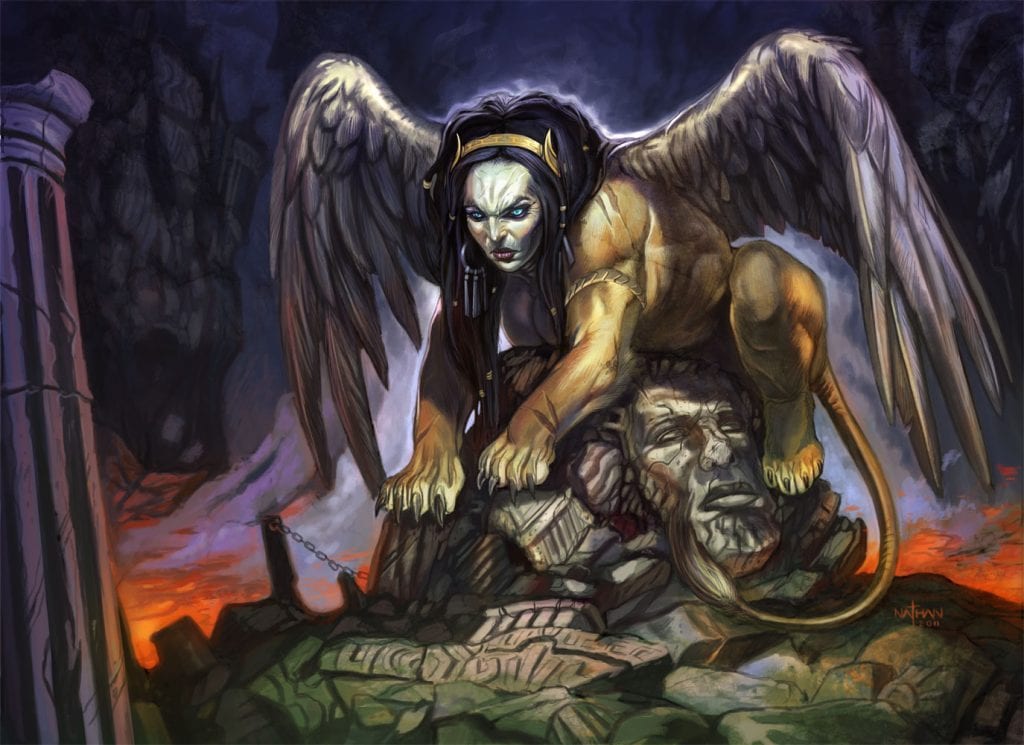From the ancient Egyptian hieroglyphs to the oral tradition of Inuits and urban legends of the present day, mythical creatures are an integral part of any folklore or mythological account.
For as long as human beings existed, there have been stories of monsters, legendary beasts and unimaginable, supernatural beings. Some were vile creatures of darkness while some were benevolent and even heroes to the mankind. Some still walk the earth if you ask the right person.
But how well do we know our monsters? There are hundreds of them after all. Well, this article, which will be updated regularly with new additions, was written to be your guide in that sense.
For those who have been wondering about them, here is our ultimate mythical creatures list:
Table of Contents
Acephali
Acephali were human-like creatures that were believed to have lived in Libya. Acephali had their faces on their chests because their heads were removed by gods as a result of a rebellion.
Some were able to find their removed heads and carry them under their arms. The word acephali literally means “without a head”.
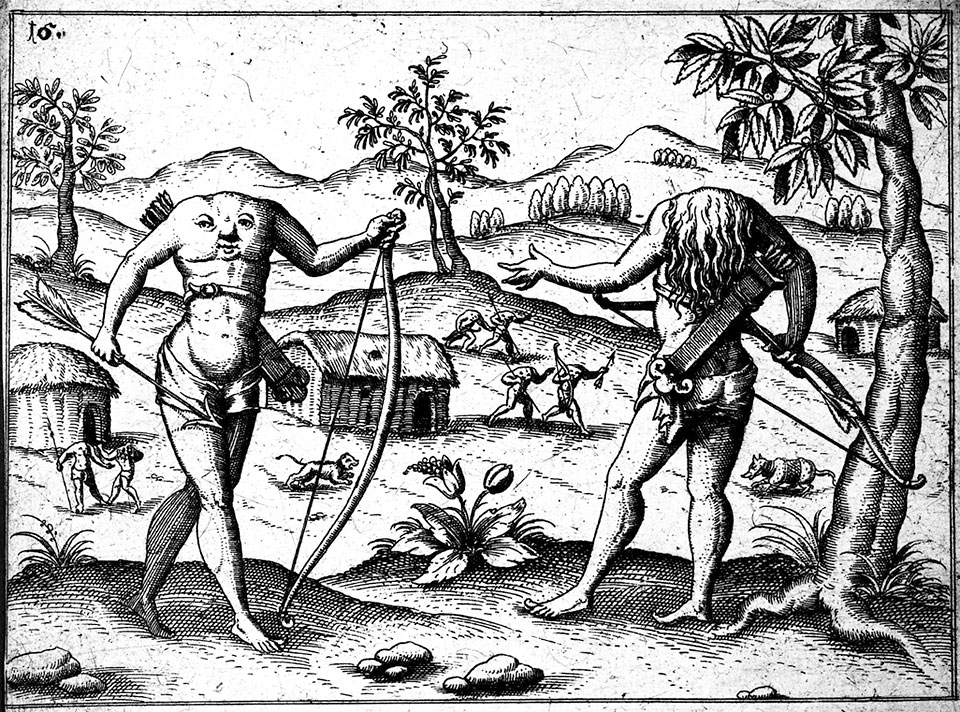
Also known as Acephalos, Acephalites, Akephalos and Akephale, these creatures were mentioned mostly in the works of Herodotus and Josephus.
Acheri
Acheri is a mythical creature in Native American folklore which is believed to be a revenge spirit. According to the belief, Acheri is a ghost of a young girl that died a terrible death either by being murdered or by being left to die after being abused.
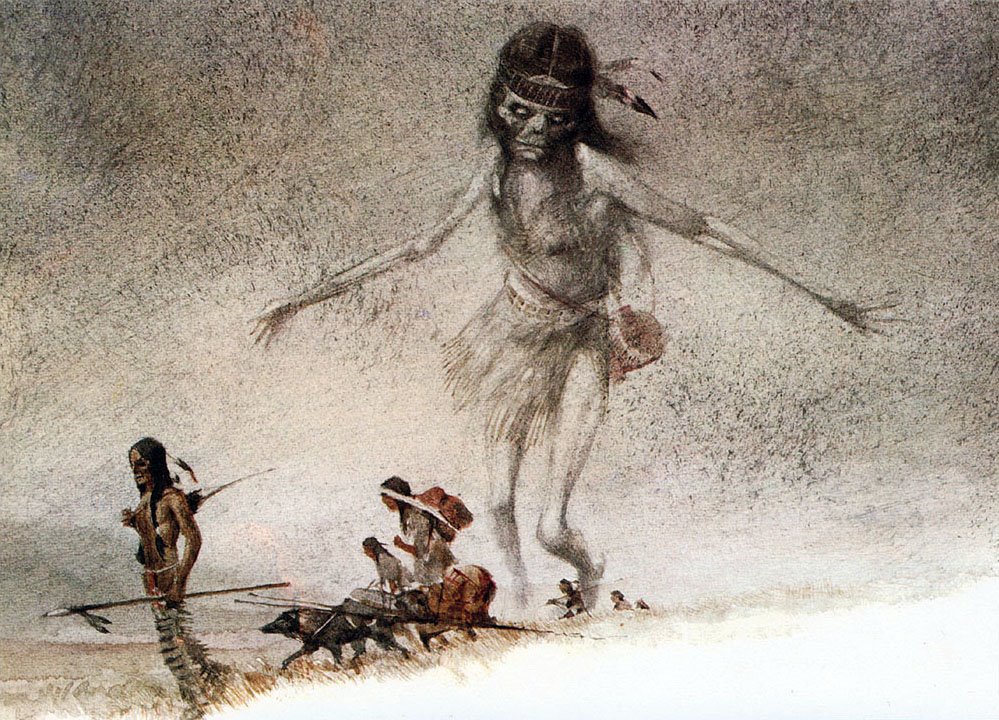
Wandering around mountainsides, Acheri comes down at night to spread death especially among children by making them sick.
Casting its shadow is enough for acheri to make children sick. Although it is a revenge spirit, it does not target specific individuals and very rarely adult people.
It is believed to lure some children back to its home in some cases.
Wearing red clothes, bracelets or necklaces is said to provide protection against Acheri.
Al-mi’raj
The third creature in our list of mythical creatures hails from the East. Al-mi’raj is a mythical creature in Islamic mythology which is basically a hare (rabbit) with a single horn on its forehead much like a unicorn.
Al-mi’raj lived on a mysterious island named Jezîrat al-Tennyn within Indian Ocean.
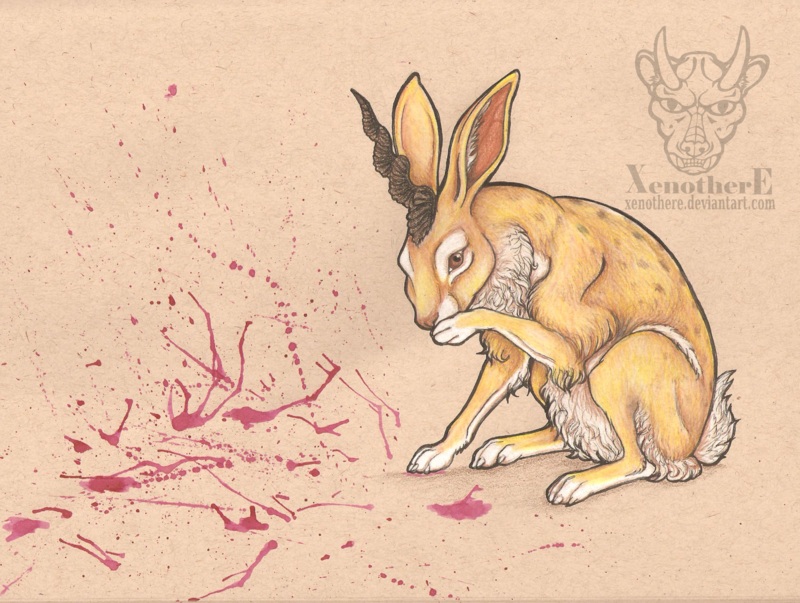
Despite its harmless appearance, this beast could kill creatures much larger than itself by stabbing them with its horn and then devour them.
According to the belief, only a true witch could render Al-mi’raj harmless ensuring others to come close and carry the beast away.
Amarok the Wolf
Amarok, also known as Amaroq, is a giant wolf in Inuit mythology which was believed to kill people hunting alone.
One of the few legends regarding Amarok suggests that a boy who was unable to move and disliked by his people prayed for the god of strength and Amarok came to his aid.
Knocking the boy down with its tail, Amarok broke some bones in his body and told the boy that he could not move before because of those bones.
The boy came to wrestle with Amarok daily and become so strong that he beat three bears and earned respect from his people.
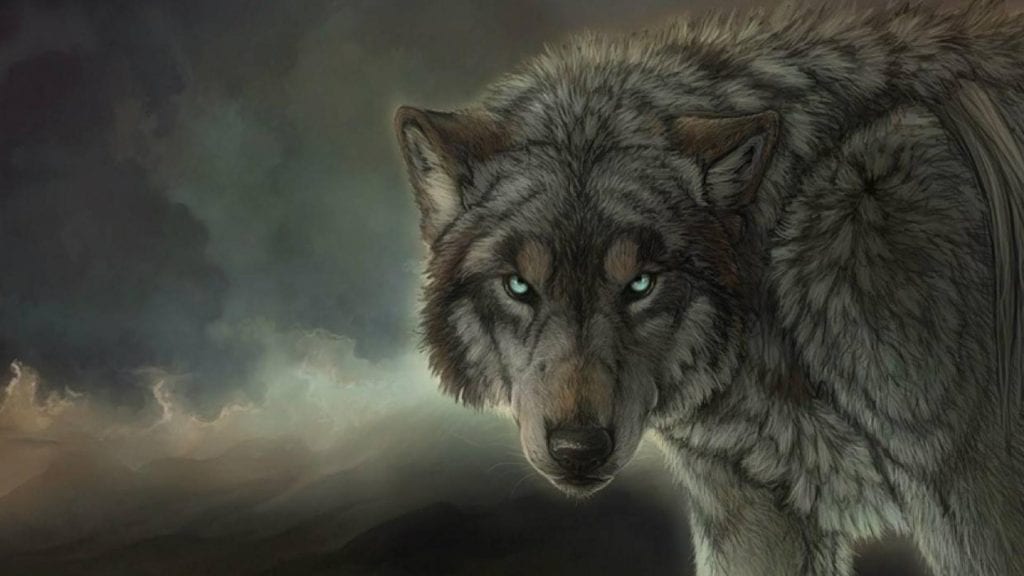
Although its origin is also linked to shunka warakin, hyaenodon and waheela, the myth of Amarok was most likely based on stories about direwolves told by ancient Eskimo people.
Banshee
A banshee is a female spirit from Irish folklore believed to be the harbinger of death.
Banshees, known as “crying/wailing women”, heralded the death of a person, a relative in most of the stories.
Banshees looked like young women combing their hair with a silver or golden comb or sometimes old women.
They also had red eyes because they wept all the time.
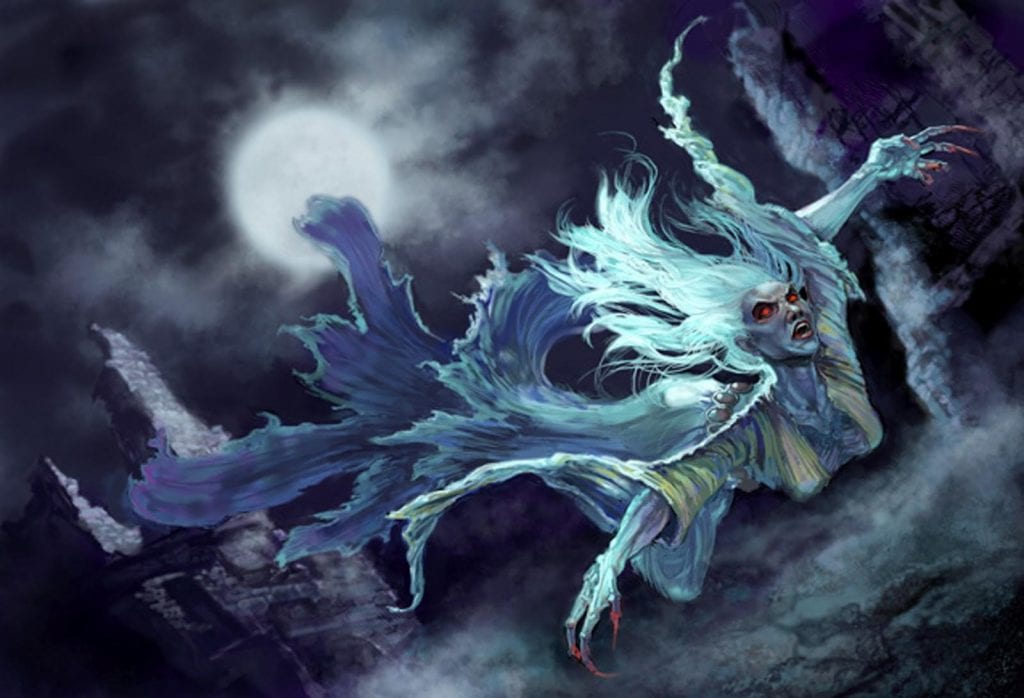
According to the myth, King James I of Scotland met one of these wailing women who told him that he would be killed by Earl of Atholl and his co-conspirators. He actually fell victim to their conspiracy eventually.
In the old times, people were warned about not to pick a comb if they found one as it might have belonged to a banshee.
Doppelganger
Doppelgangers are the legendary creatures that were told to be the double spirits of people.
Although they looked exactly the same with the person in question, doppelgangers were not the twins of those people.
According to the belief, doppelgangers had no reflections in the mirror or cast shadows.
Seeing a doppelganger was considered a bad omen.
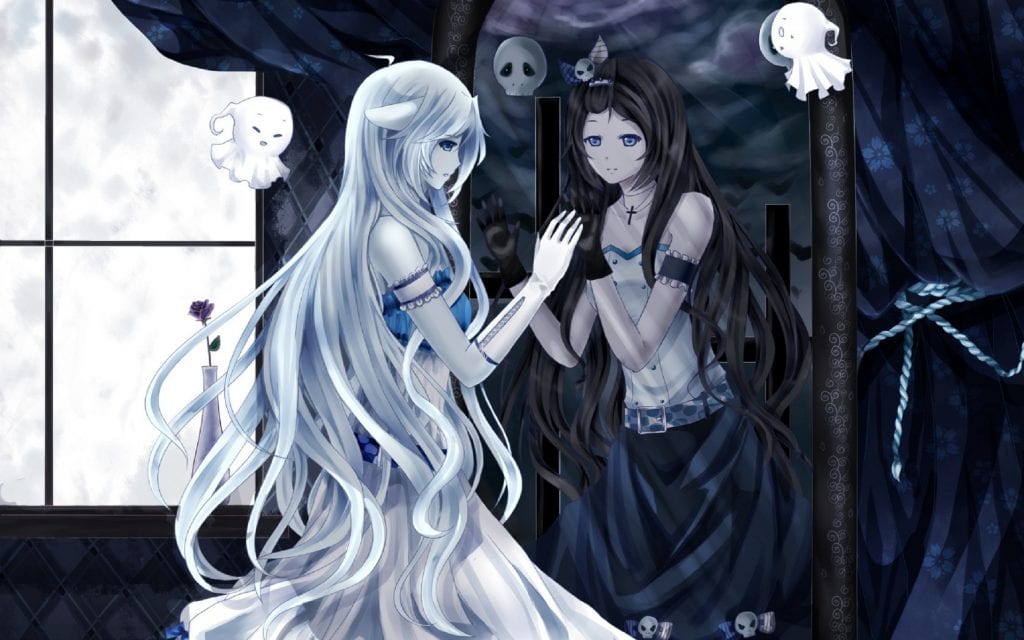
Noah Brooks suggested in his book Washington in Lincoln’s Time that Abraham Lincoln saw his doppelganger and his wife told him that he would not live to serve his second term as the president of USA. Lincoln was killed right after he was chosen to be the president for a second term.
Also, John Dunne, the famous English poet said he saw the doppelganger of his wife when he was in Paris. He came back home to find out that his wife gave birth to a stillborn baby.
Basilisk
Basilisk is a legendary giant reptile in European mythology which was known as the king of serpents. The word basilisk is derived from the Greek word basiliskos meaning “a kind of serpent”.
There are three ways the basilisk was depicted in the myths: a giant snake, an enormous lizard or a reptile with scaly wings and some features of a roster like feathers, legs and head.
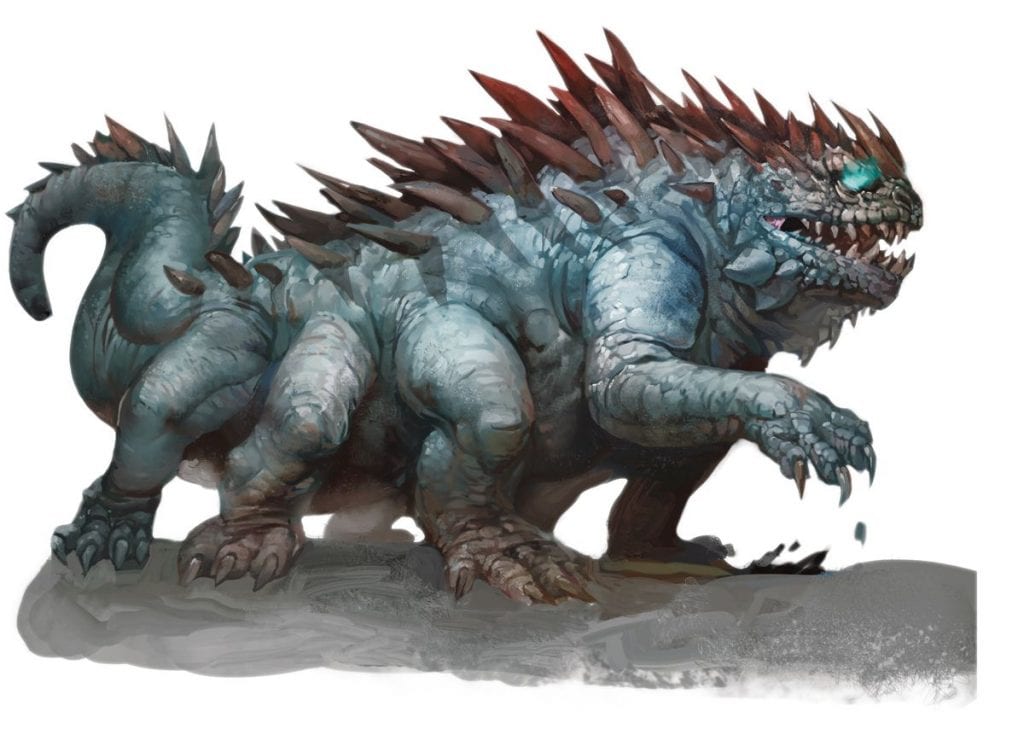
According to the belief, the basilisk could kill anything with just looking in its eyes much like Gorgons in Greek mythology.
Some other myths suggest that the basilisk could fly, deliver venom by biting its prey and/or breathe fire.
Loup Garou/Rougarou
Loup garou is one of the most popular mythical monsters throughout the world joining our list from Cajun and French Canadian folklore.
Also known as rougarou, this creature is basically French and Cajun counterpart of a werewolf.
A person becomes a loup garou if he or she is put under a specific loup garou curse. On the other hand, French Catholics believed that a person became a loup garou if he broke the rules of Lent for 7 years in a row.
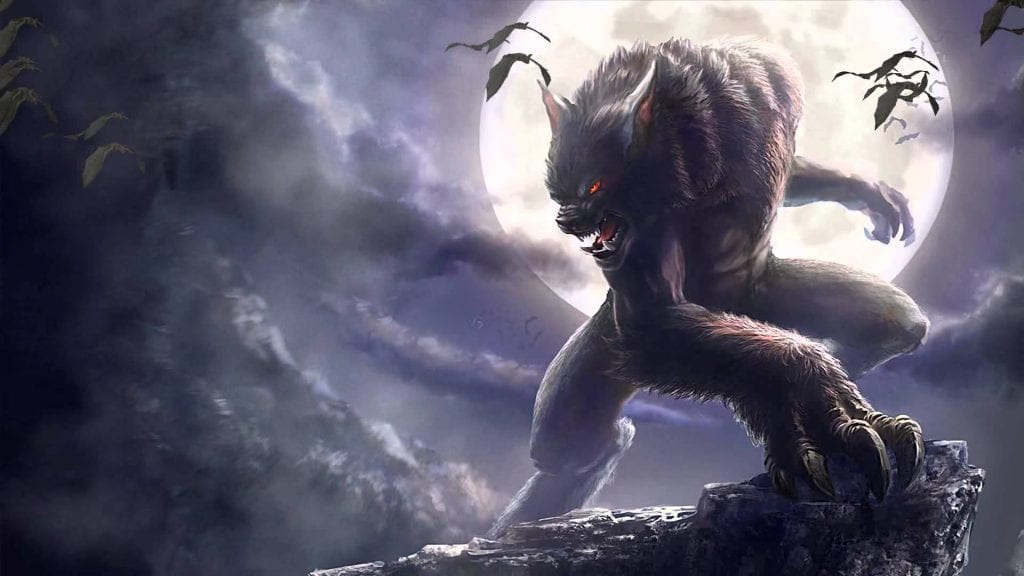
Loup garous are very agile and strong creatures. They are weak against fire which is considered by many people to be the only way to kill them.
Cutting the head off or cutting the whole body into pieces are believed to be the other ways to kill a loup garou.
If you would like to learn more about this creature, read our detailed article about loup garous here.
Briareus
Here comes the first of Greek monsters in our mythical creatures list. Also known as Aegaeon, Briareus is one of the Hecatoncheires in Greek mythology born from Uranus and Gaia. Briareus, the son of these major deities representing Heaven and Earth, had 100 arms and 50 heads.
The word Hecatoncheires is actually derived from Greek words meanings “hundred hands” although some accounts suggest the word briaeros simply means strong.

Some accounts (by Homer and Hesiod) suggest that Briareus and his brothers helped Zeus while he was battling Titans.
On the other hand, some accounts (Hymn to Delos by Callimachus) have Briareus as an enemy of Zeus who was buried under Mount Etna after he was defeated and killed.
Another account refers to him as the god of sea-storms who wed Kymopoleia, one of Poseidon’s daughters. This is the reason he is identified as Aegeon/Aegion (which means something like “of the Aegean Sea”)
Brynhildr
Also known as Brunhild, Brünnhilde, Brynhild, Brynhildr is a valkyrie and a shieldmaiden in Norse and Germanic mythologies.
According to the belief, Odin punished Brynhildr to live as a mortal woman after she decided Agnar was the winner of a fight between King Agnar and King Hjalmgunnar, who was preferred by Odin.
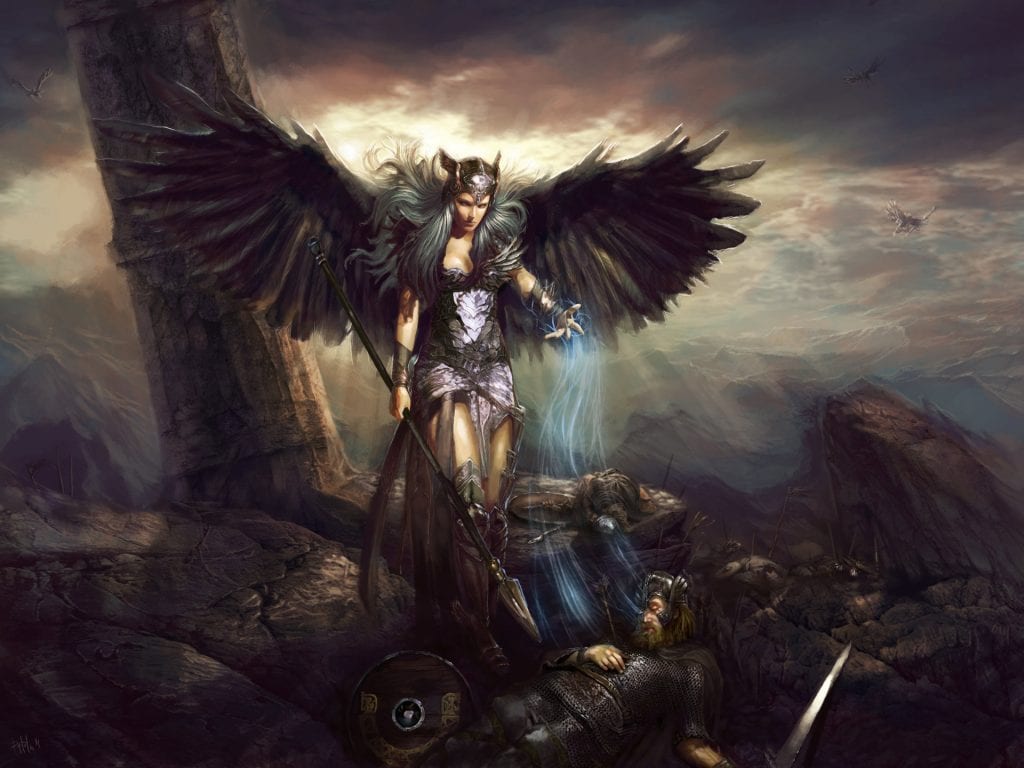
Imprisoned in a castle on top of Mount Hindarfjall, Brynhildr got rescued by the hero of the Volsung saga Sigurdr Sigmundson after he killed the dragon Fafnir.
The two fell in love and got married after Sigurdr proposed Brynhildr with the legendary ring Andvaranaut.
On a side note, Brynhildr is known as the mother of Aslaug (Kraka), one of Ragnar Lothbrok’s wives.
Upir
Upir is the word used to describe vampires in Slavic cultures although there are some slight difference between the myth regarding upirs and vampires.
As one of those differences, upirs had the ability to walk during the day and did not burn unlike vampires.
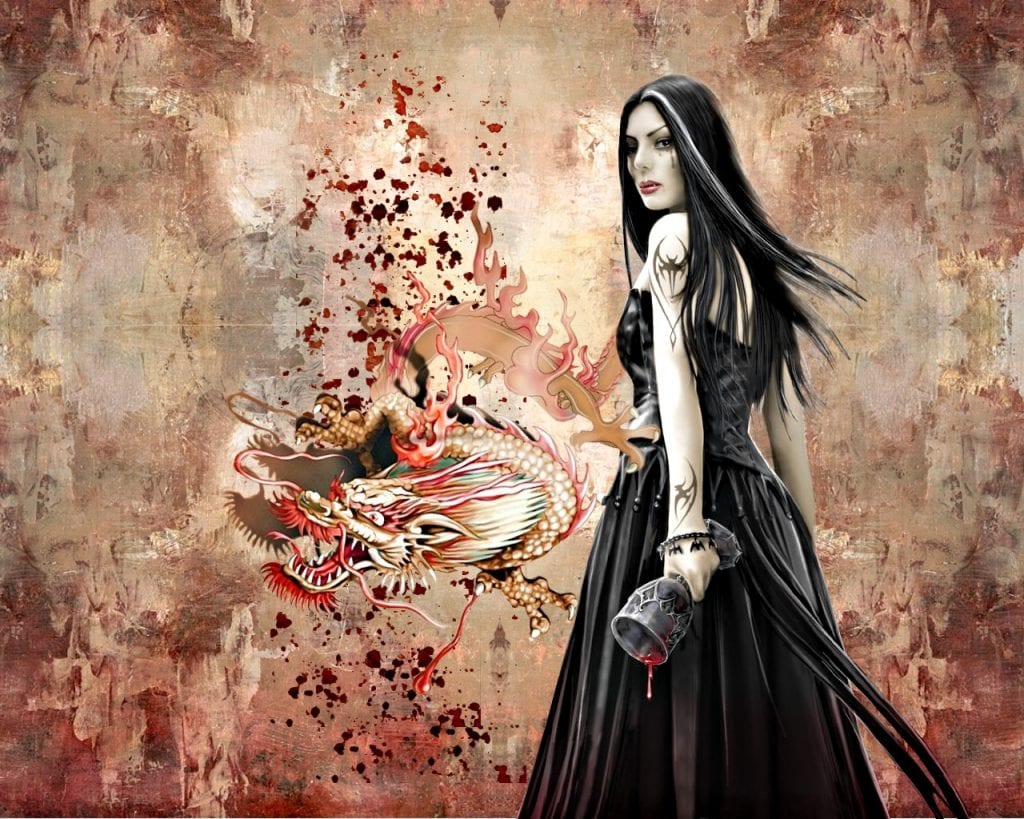
There were different opinions as to how an upir could be killed. According to the belief, staking an upir in the heart with a blessed stake would kill the creature while some other people suggested staking in the heart while sinking them in holy water was the way to kill upirs.
Decapitation and incineration were mentioned in the stories as other ways of killing upirs. If you would like to read more about the myth regarding this mythical creature, read our detailed post on upirs here.
Centaur
Centaurs, also known as Ixionidae, are mythical creatures in Greek mythology with the torso and head of a human being and the body of a horse.
As one of the most popular Greek monsters in mythology, centaurs are known as the children of Nephele (a cloud created in Hera’s image) and Ixion, a king of Lapiths, the most ancient tribe of Thessaly.
Some accounts, however, suggest that centaurs were born from the unity of Magnesian mares and Centaurus (a single centaur considered to be the father of all centaurs).
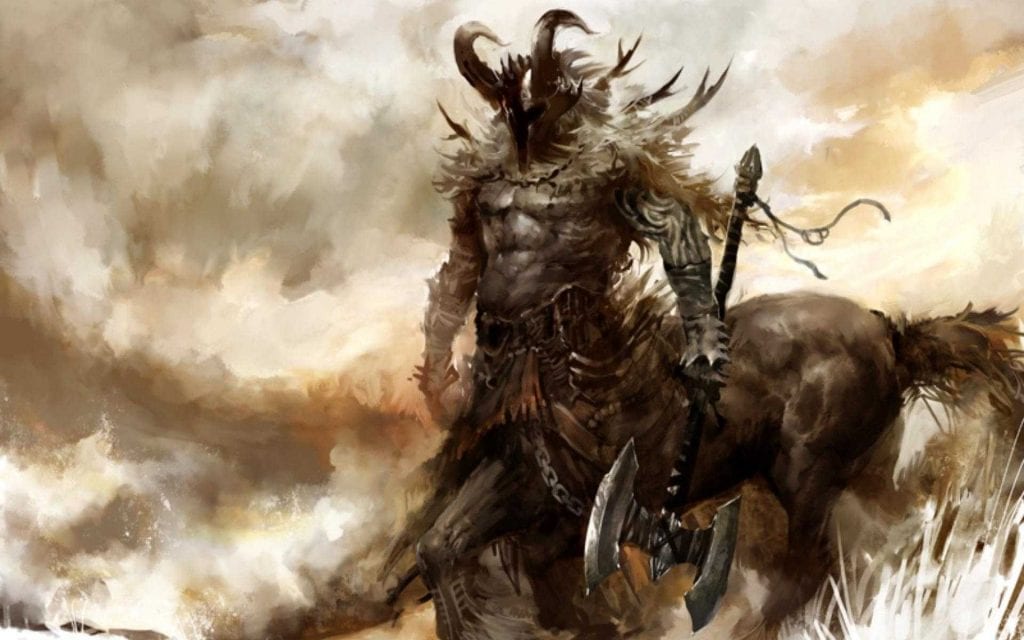
The most significant centaur mentioned in the myths is Chiron who was known to be a mentor to some important characters in Greek mythology like Achilles and Aesculapius.
Despite being immortal, Chiron, accidentally shot by one of Heracles’ arrows (on which Heracles applied the blood of the Hydra) fell into great agony.
Later, when Heracles asked Zeus to let Prometheus free and Zeus asked for a sacrifice, Chiron volunteered and died to free Prometheus and end his own suffering.
Cerberus
One of the most prominent mythical monsters in Greek mythology, Cerberus, also known as Kerberos, is the giant hound with three heads guarding the gates of the underworld in Greek mythology.
The hound of Hades, which is the child of two monsters, Typhon and Echidna, is depicted as a monster with three heads, a serpent as its tail and a body from which snakes come out.
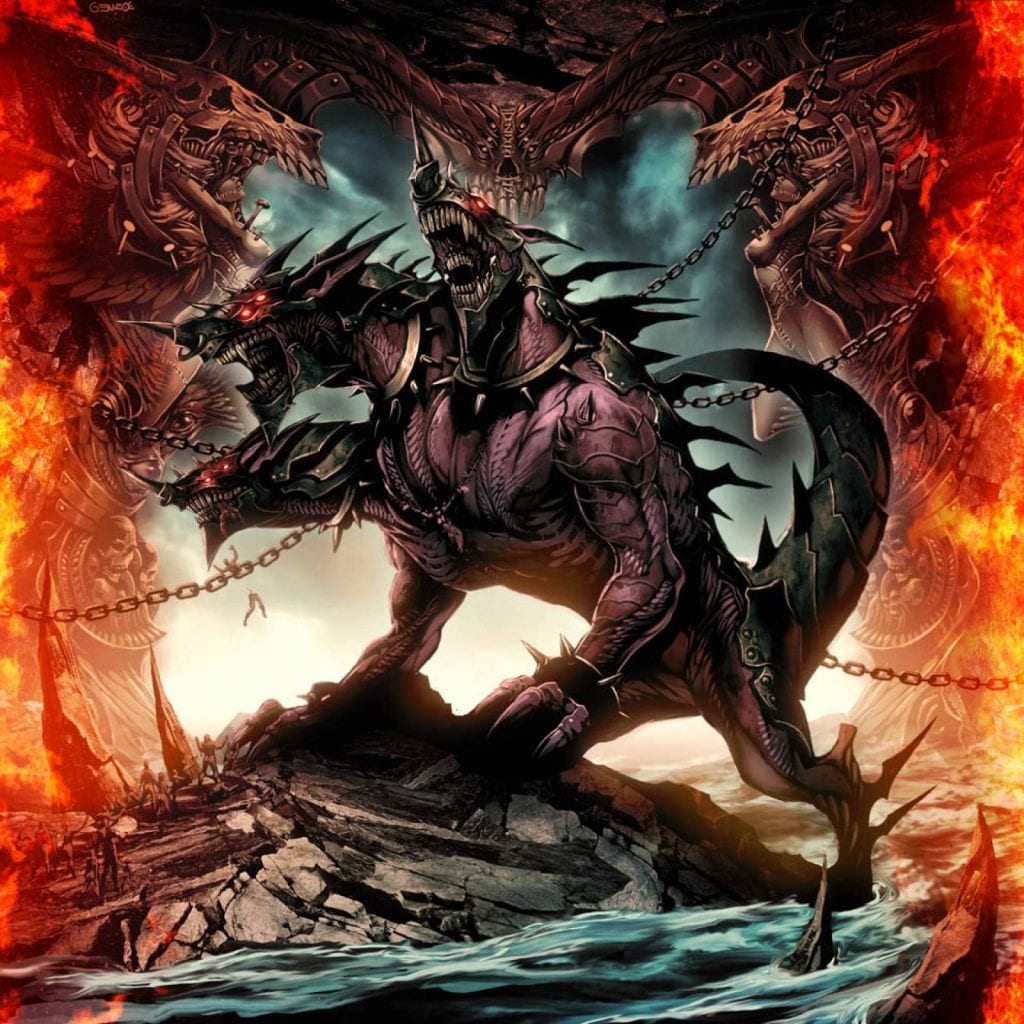
As the twelfth labor of Heracles/Hercules, Cerberus was captured by Heracles and brought to Eurystheus after which he returned the hound to the underworld (although some versions of the myth has Cerberus escaping and returning to the underworld by itself).
Chimera
Chimera, also known as Khimaira or Chimaera, is a mythological creature formed of three animals, a lioness, a snake and a goat.
Chimera’s body had three heads on her body: one that of a lioness as for her head, a goat’s head on her back and the head of a snake at the end of her tail.
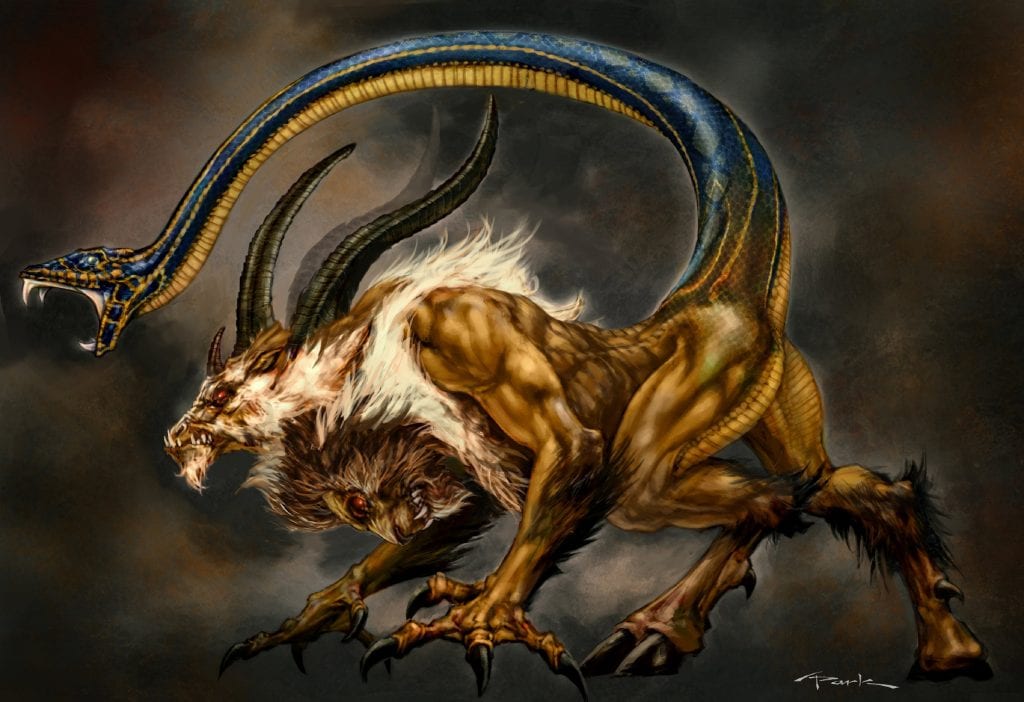
Just like Cerberus, Ladon and the Lernean Hydra, Chimera was a child born from two monsters Typhon and Echidna.
Chimera could breathe fire according to Homer’s Iliad and Hesiod’s Theogony.
In the most famous myth regarding the creature, the Lycian King Iobates sent Bellerophon to kill Chimera since she has been killing cattle and setting fires throughout the country. Bellerophon killed Chimera with the help of Pegasus.
Read our more detailed article if you would like know more about Chimera.
Orthrus
Orthrus, also known as Orthus, was the two-headed hound that guarded the cattle of Geryon in Greek mythology.
He was one of Echidna and Typhon’s children (like Cerberus, the Lernean Hydra, Chimera and some other monsters in Greek myths) and was killed by Heracles while he was fulfilling the tenth of the twelve tasks/labors given to him by Eurystheus: capturing cattle of Geryon.
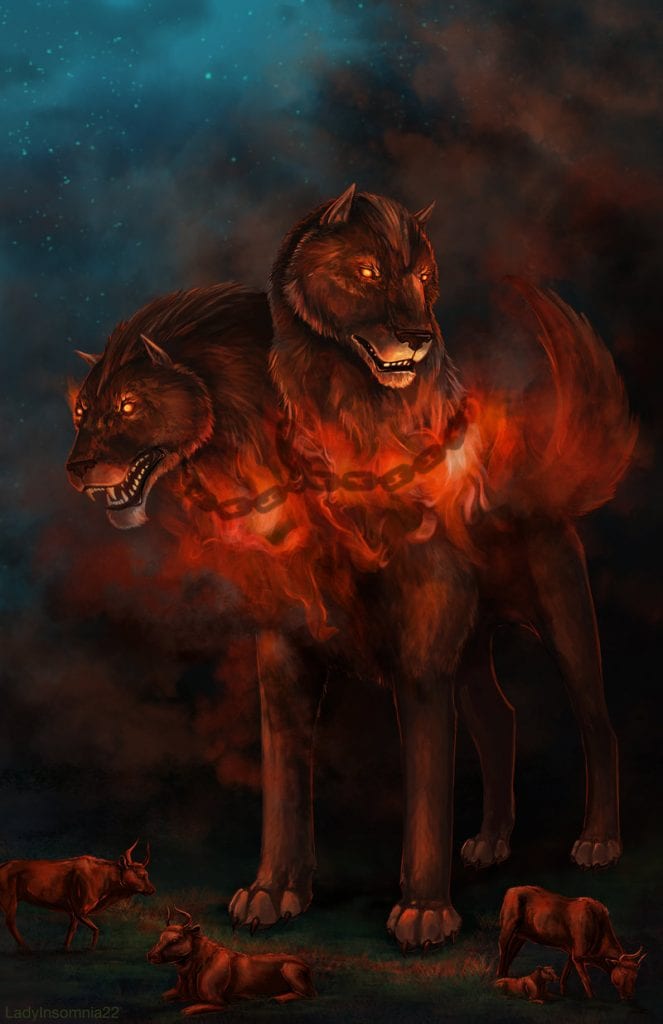
Sphinx
Sphinx is a legendary creature mentioned in Greek and Egyptian myths. According to the legend, the Greek sphinx had a lion’s body, a woman’s head and an eagle’s chest and wings (and the tail of a serpent in some versions of the accounts).
Egyptian sphinx, on the other hand, was shown as a male. As for another difference between these two legendary beasts, Greek sphinx was a merciless and treacherous creature while her Egyptian counterpart was a benevolent figure in Egyptian mythology.
Both creatures were considered as guardians of important places like temples and were featured at entrances to such places.
While the sphinxes as a species were depicted in many ancient artworks, the most significant one in Greek mythology was the one that laid waste to the city of Thebes in Greece sent by the gods as a punishment for a crime people committed.
According to the story, King Creon (Kreon) of Thebes promised the throne of the kingdom to the person who could slay the Sphinx.
In the first version of the myth, the Sphinx stood guard at the gates of Thebes and asked riddles to the travelers who wanted to enter the city. She killed and ate them if they could not answer her riddles correctly.
In the second version of the myth, the Sphinx, which has been destroying the city for a while, refused to leave Thebes unless somebody answered her riddles correctly.
When King Creon offered the throne of the city to the person who could defeat Sphinx, Oedipus accepted the challenge. He could actually answered the riddles correctly ending in the Sphinx killing herself by jumping off the mountainside.
Nemean Lion
The Nemean lion was a legendary gigantic lion in Greek mythology believed to be one of Echidna and Typhon’s offspring although some myths suggest that he was a child of Zeus and Selene (the goddess of moon) and fell from the moon while another origin story of his featured him as the child of Chimera.
The Nemean lion had golden skin which was impenetrable to the weapons of mortals and his claws were sharper than any sword used by mortals.
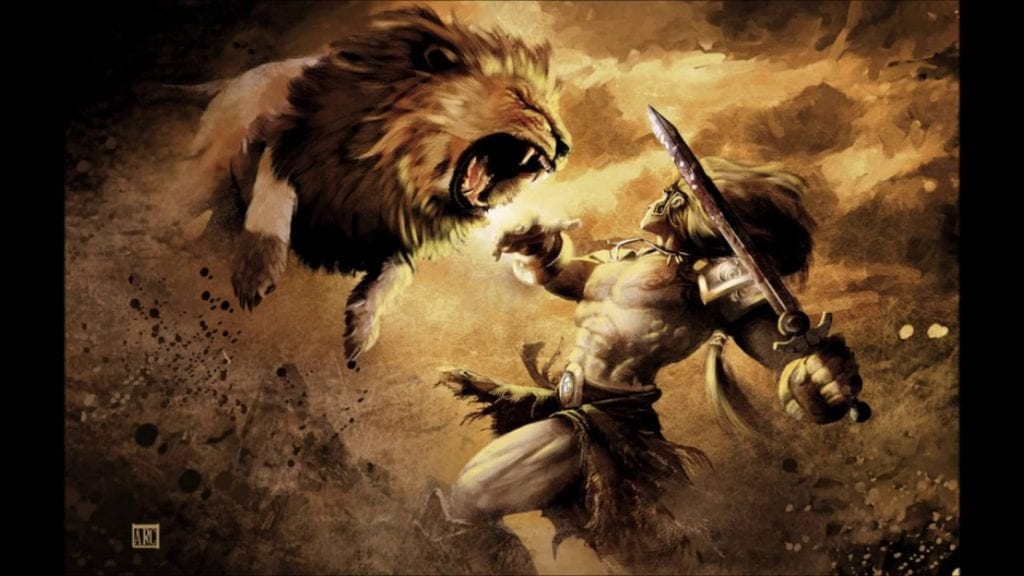
As the first one of his twelve labors, Heracles was asked to kill the giant lion which has been terrorizing Nemea, a city in the Peloponnesus area.
When he finally found the lion, Heracles shot arrows at him only to realize that his skin was impenetrable.
To prevent the lion from escaping, Heracles blocked one of two entrances to the cave and followed him back into the cave. He killed the lion by strangling him with bare hands as that seemed to be only thing that worked.
On a side note, some accounts suggest that he killed the lion by shooting it in the mouth, the only part of the beast’s body that was unprotected.
Ladon
Ladon, also known as the Hesperian Dragon, was a dragon with hundred heads that guarded the golden apples of Hesperides.
Stealing the golden apples of Hesperides was the eleventh labor of Hercules set by King Eurystheus.
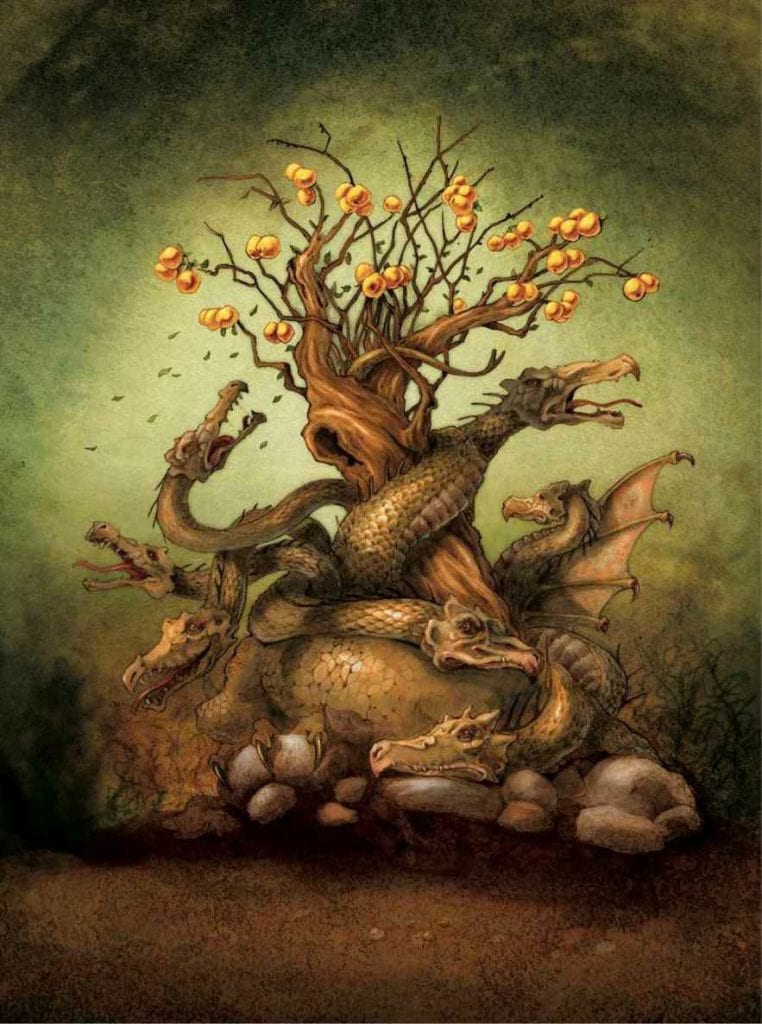
After wandering Egypt, Libya and Asia for a long while, Hercules finally found the garden, killed Ladon and stole the golden apples.
Lernean Hydra
The Lernean Hydra, also known as the Hydra of Lerna, was a mythical creature in Greek and Roman mythologies that lived in the lake of Lerna in the Argolid region.
Like Cerberus, Chimera and many other Greek monsters in mythology, the Lernean Hydra was also known as the offspring of monsters Typhon and Echidna.
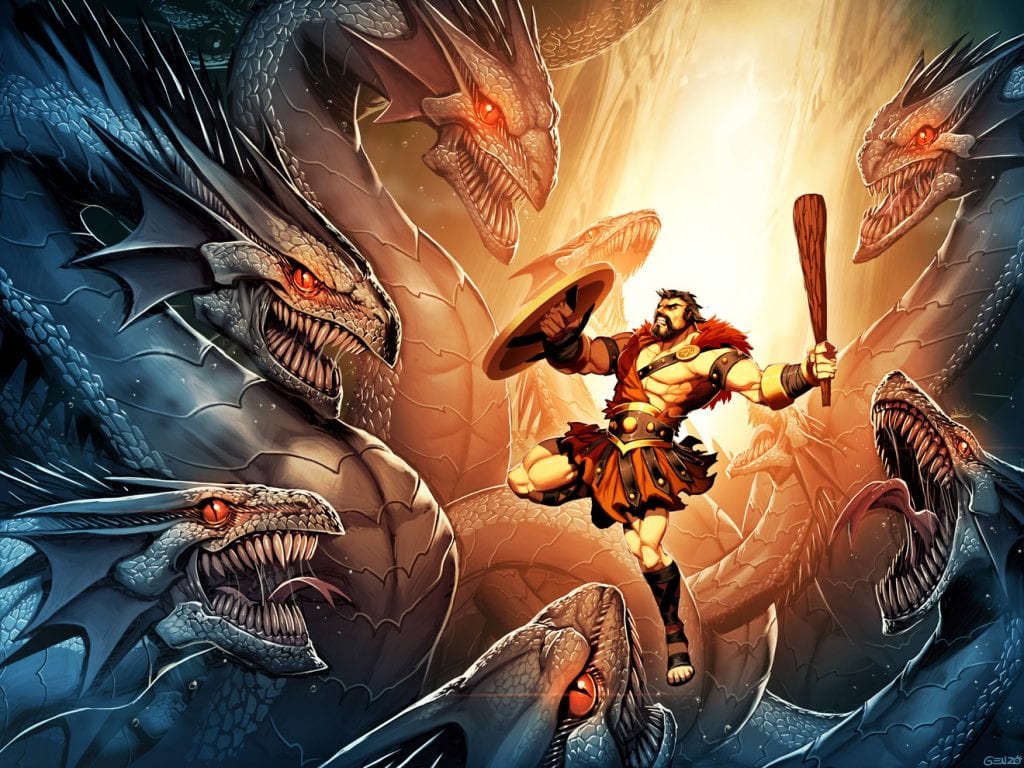
According to the belief, the Lernean Hydra had nine heads, she breathed poison and her blood was so deadly that even the scent of it was enough to kill.
The Lernean Hydra was killed by the divine hero Hercules as it was the second one of his labors set by King Eurystheus.
In the myth, every time Hercules cut off one of the Lernean Hydra’s heads two new ones replaced it. In the end, Hercules asked for help from his nephew, Iolaus. Iolaus burned off Hydra’s necks as Hercules cut the heads off. That worked and Hercules finally slew the beast.
As a modern reference, the evil Hydra organization in the comic books by Marvel Comics, TV shows like Agents of S.H.I.E.L.D and movies in Marvel Cinematic Universe used the Lernean Hydra as its symbol along with the motto “If a head is cut off, two more shall take its place”.
Caucasian Eagle
The Caucasian Eagle was a giant eagle tasked by Zeus to torture Prometheus as his punishment for stealing fire from the gods.
Chained to the peak of Caucasus Mountains, Prometheus had a piece of his liver eaten every day by the Caucasian Eagle.
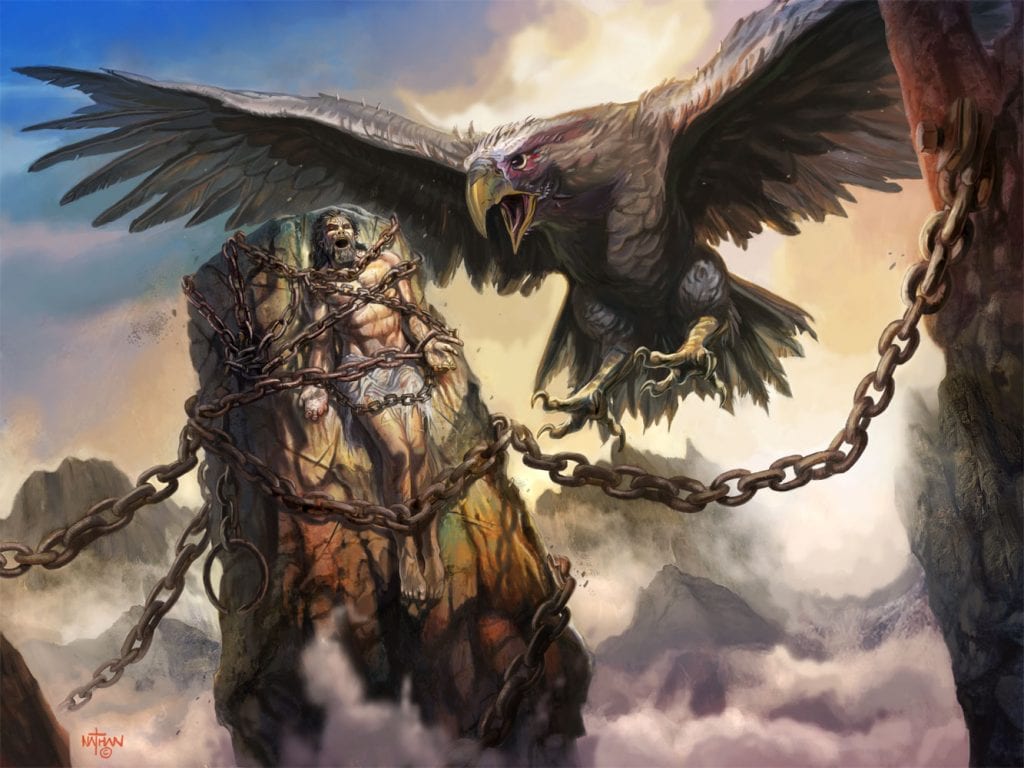
Some myths suggest the Caucasian Eagle was an automaton crafted by the blacksmith god Hephaestus while others suggest that the eagle was another one of Typhon and Echidna’s offspring.
While he was on his way to steal the golden apples of Hesperides as his eleventh labor, Hercules saw the Caucasian Eagle torturing Prometheus and felt sorry for the titan. He killed the eagle and ended Prometheus’ suffering.
Arachne
Arachne is a legendary creature in Greek mythology mentioned as the first spider in the world.
According to the legend, Arachne was firstly a human being, a young woman with excellent skill in weaving who was too proud of her work.
When asked whether her amazing gift of weaving was given to her by Athena, Arachne said she did not need any teaching from Athena and challenged the goddess for a weaving competition.
Disguised as an old woman later on, Athena tried to warn Arachne to be respectful and not offend gods but Arachne kept acting in an insulting and disrespectful manner. Athena revealed herself and accepted her challenge.
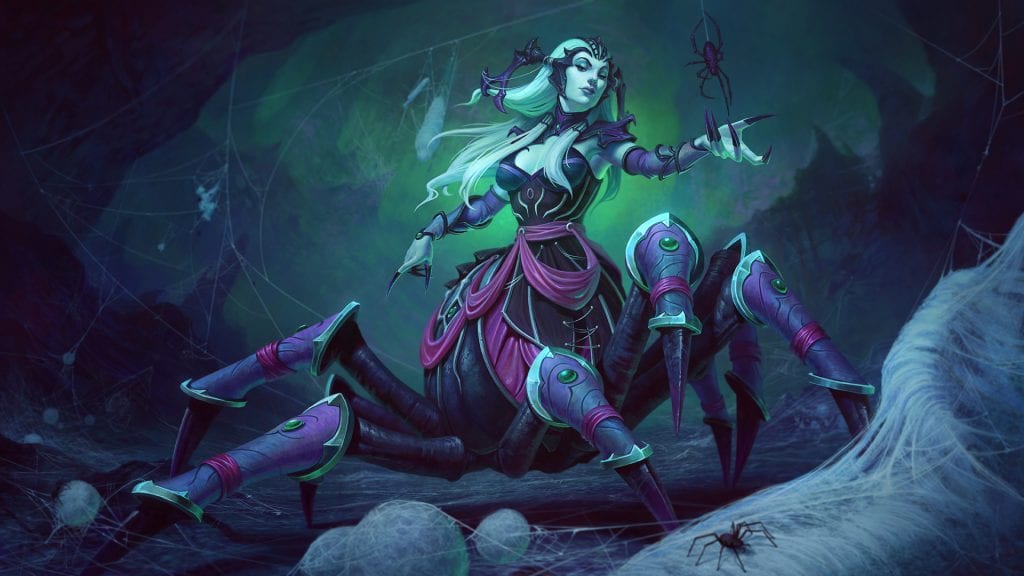
According to the first version of the myth, Arachne’s work for the competition was insulting on gods as she pictured them in shameful ways.
Athena touched Arachne’s head (or hit according to some accounts) and made her feel shame and guilt for her insult on gods. Arachne killed herself after that but, feeling sorry for how things developed, Athena did not let her die and turned Arachne into a spider.
In the second version of the myth, Arachne did an excellent job but her work was not even close to Athena’s work.
Having won the contest and seeing Arachne’s passion for weaving, Athena turned her into a spider and commanded that she and her descendants would weave until the end of time.
Cyclopes
The Cyclopes were one-eyed primordial giants in Greek mythology known as the sons of Uranus and Gaia while Homer suggested in his works that they were actually the sons of Poseidon.
The Cyclopes were lawless creatures that lived freely and did not fear the gods. They were also known to be the workers of the divine blacksmith Hephaestus.
The most significant one among the Cyclopes was Polyphemus featured in Homer’s work Odyssey. On his way back home, Odysseus arrived at the island of Cyclops (Sicily) where Polyphemus, the man-eating giant lived.
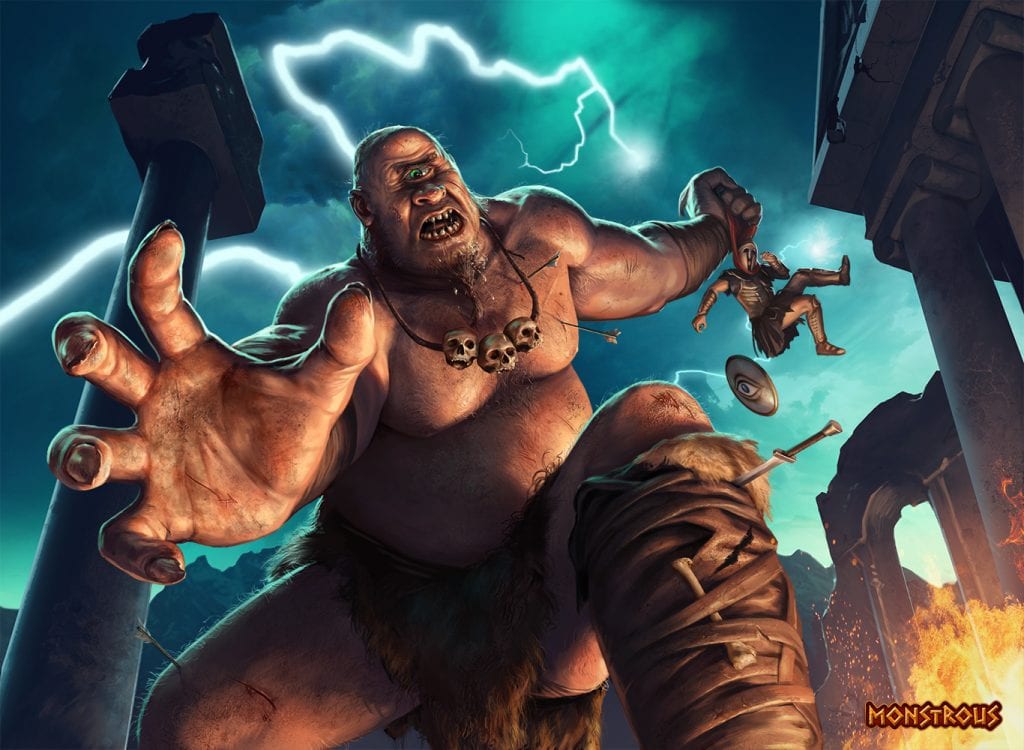
Polyphemus caged Odysseus and his men in his cave when they were trying to eat his food. He ate four of Odysseus’ men but Odysseus managed to fool him and get him drunk.
After Polyphemus fell asleep, Odysseus stabbed him in his only eye and he and his men escaped from the cave the next morning by tying themselves under the sheep Polyphemus took out to graze.
Harpies
Harpies are mythical creatures in Greek and Roman mythologies with the head of a woman and the body of a vulture (although some myths suggest exactly the opposite).
The word “harpy” is considered to be derived from the Greek word harpyia meaning “the one that steals”. This is thought to be the reason why these creatures were given the name.
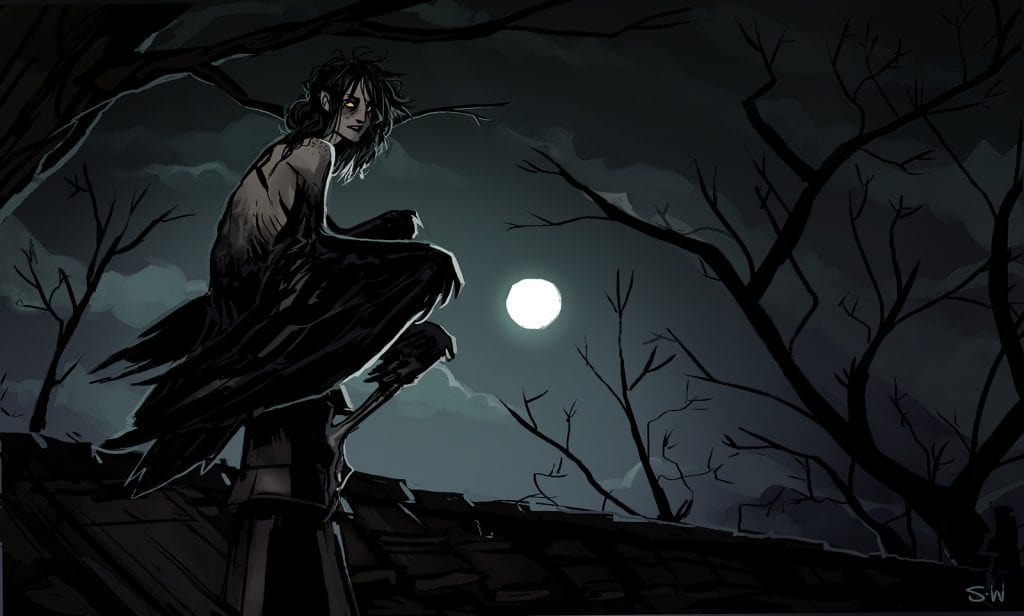
In Greek mythology, harpies were Zeus’ servants and one of the most significant myths about harpies have them punishing the King of Thrace, Phineus.
Zeus wanted to punish Phineus since he used his talent for prophecy to disclose secrets of gods. He ordered harpies to steal whatever food was put in front of him.
His punishment went on until Jason and the Argonauts came to his rescue on the island where he lived.
Medusa
As the next item in our list of mythical creatures, Medusa is another addition from Greek mythology. Medusa was one of three Gorgon sisters born from ancient marine gods Phorcys and Ceto, the offspring of Oceanus and Gaia. While her sisters Stheno and Euryale were immortals Medusa was a mortal being.
Medusa was a creature in the form of a human female with snakes for her hair. She had the ability to turn into stone anyone that looked in her eyes.
Originally, Medusa was a priestess of Athena with golden hair. She made a vow of celibacy for life but, being seduced by Poseidon, she broke her vow and married him.
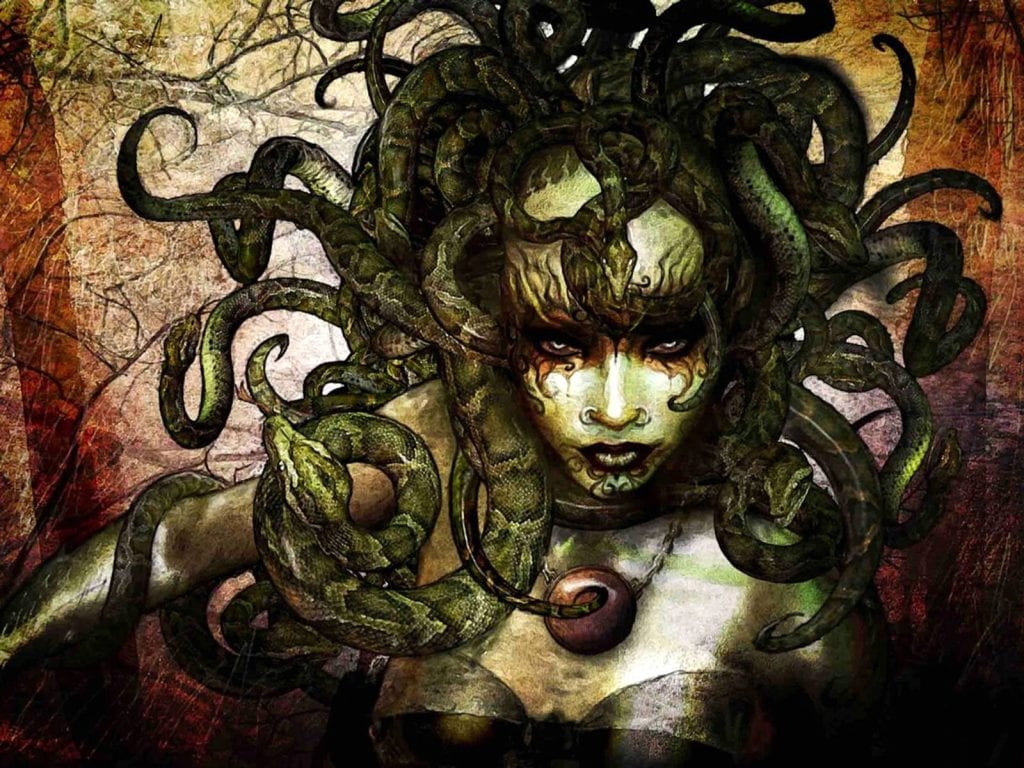
Greatly offended by this, Athena punished Medusa by turning her hair into snakes, making her eyes ugly and bloody so that everyone looking at them would feel disgust and giving her beautiful white skin a hideous green tone.
Medusa ran away from her home and wandered around for a long time slowly becoming the horrible creature fitting her appearance. Her misery ended when, tasked by King Polydectes of Seriphos, Perseus beheaded her in her sleep.
Ancient Greeks believed that, while running away from one place to another in despair, Medusa wandered around Africa and the snakes dropping from her hair were the reason why the continent became so densely populated with venomous snakes.
Minotaur
Carrying on with the monsters and beings in Greek mythology, this list of mythical creatures would certainly not be complete without the Minotaur. The Minotaur was a mythical creature born from the intercourse between the Cretan Bull and Pasiphae, the Queen of Crete.
King Minos of Crete offended Poseidon and Poseidon put Queen Pasiphae under a spell that made her fall in love with the Cretan Bull in order to punish Minos. That is how the Minotaur came to be.
In most of the myths the Minotaur had the head of a bull and the body of a human while some other myths suggested vice versa.
Although Pasiphae tried to nurse him at first, being an unnatural creature the Minotaur became restless with time and started eating humans to feed himself.
That is when King Minos made the architect Daedalus and his son Icarus to build a huge labyrinth to keep the Minotaur under control.
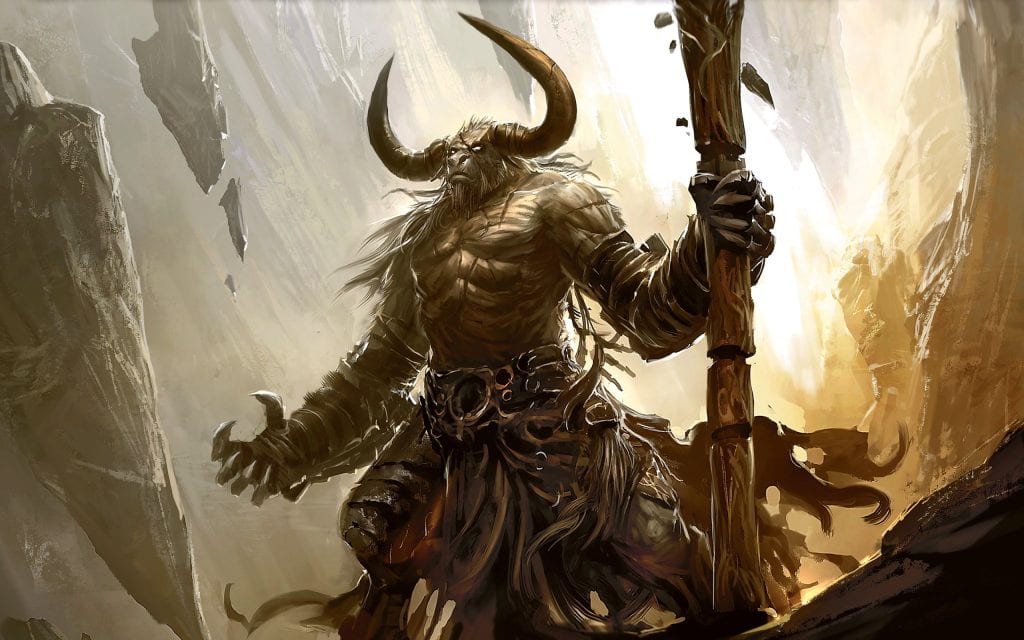
According to the myth, Athenians were accused of killing Androgeus, the son of King Minos and to pay for this sin (compelled by a great plague spread among his people) King Aegeus of Athens sent seven young men and seven maidens as a feast to the Minotaur every seven years (while some accounts suggest that this was done once every nine years and some suggest it was done once a year).
When it was time for the third sacrifice, Theseus, the great Greek hero and the son of Aegeus offered himself. When Theseus reached Crete he met Minos’ daughter Ariadne and Ariadne fell in love with him.
She helped him navigate the labyrinth by giving him a ball of tread which made him find his way back and not get lost. Theseus killed the Minotaur with the sword of his father and went back home.
Pegasus
As one of the most significant mythical creatures in Greek mythology, Pegasus, the winged horse was the offspring of Poseidon and Gorgon Medusa.
Simultaneously with his brother Chrysaor, Pegasus was given birth when Perseus killed his mother.
Some accounts suggest that these two creatures were born from the blood coming out of Medusa’s neck while others suggest that they were born from the Earth when Medusa’s blood fell onto it.
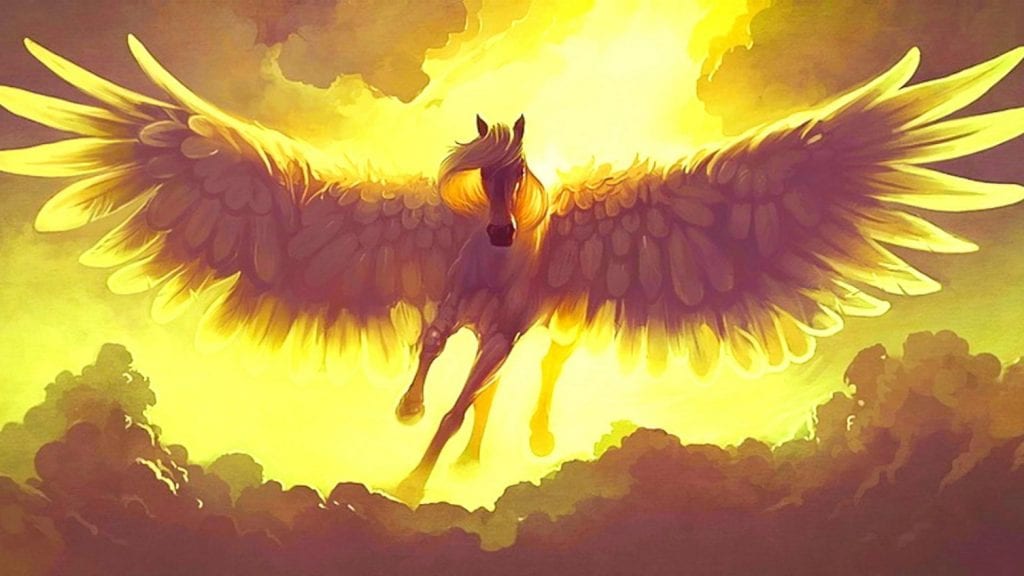
A third version of the story suggests that they were born from the mixture of sea foam, pain and Medusa’s blood implying that Poseidon played a role in their birth.
The most prominent myth featuring Pegasus is related to the fight between the Greek hero Bellerophon and the Chimera. Upon the suggestion by Polyeidos, Bellerophon slept in the temple of Athena to wake up and find Pegasus drinking water from a nearby spring.
Tamed by the hero, Pegasus helped Bellerophon greatly when he defeated the Chimera.
Scylla
Scylla was a monster in Greek mythology that lived between two rocks near Italy and Sicily.
The creature was described by Homer as a monster with twelve feet and six long necks. It had six heads with three rows of sharp teeth.
While some myths suggest Crataeis was Scylla’s mother, Hecate was also linked to be the mother in some other myths. There is no obvious mention of its father but Apollodorus suggested either Tyrrhenus or Phorcys was the father of Scylla.
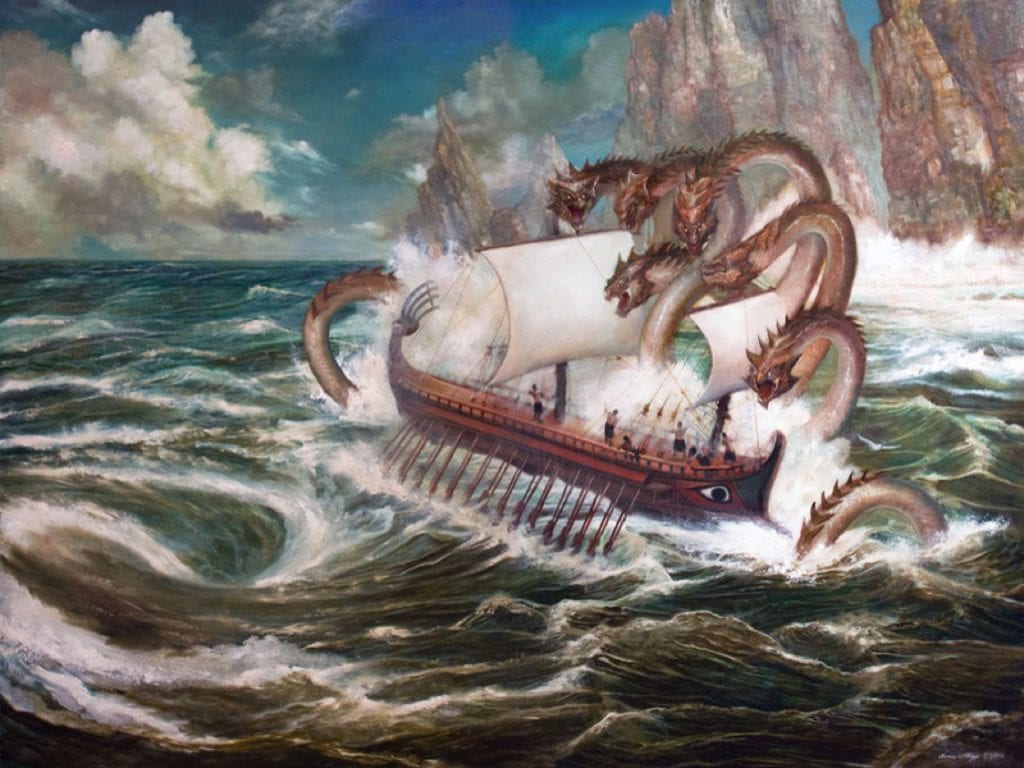
In Homer’s Odyssey, Circe tells Odysseus to sail close to Scylla rather than Charybdis, Scylla’s counterpart that swallowed the sea waters three times a day.
Circe suggests Odysseus that Charybdis might sink his ship as a whole while Scylla will only take six of his men (if he asks Crataeis, Scylla’s mother to make her offspring to attack his ship only once).
Odysseus listens to Circe and loses six of his men to Scylla while passing through.
Sirens
Sirens, also known as the Seirenes, were legendary sea-nymphs who lured sailors passing nearby to death with their beautiful voices and enchanting songs.
There are different opinions regarding the number of the Sirens but the most common belief suggested that there were three of them.
The Sirens were the handmaidens and companions of Persephone before she was abducted to the underworld by Hades. That is when Demeter gave the Sirens wings to help in the search for Persephone.
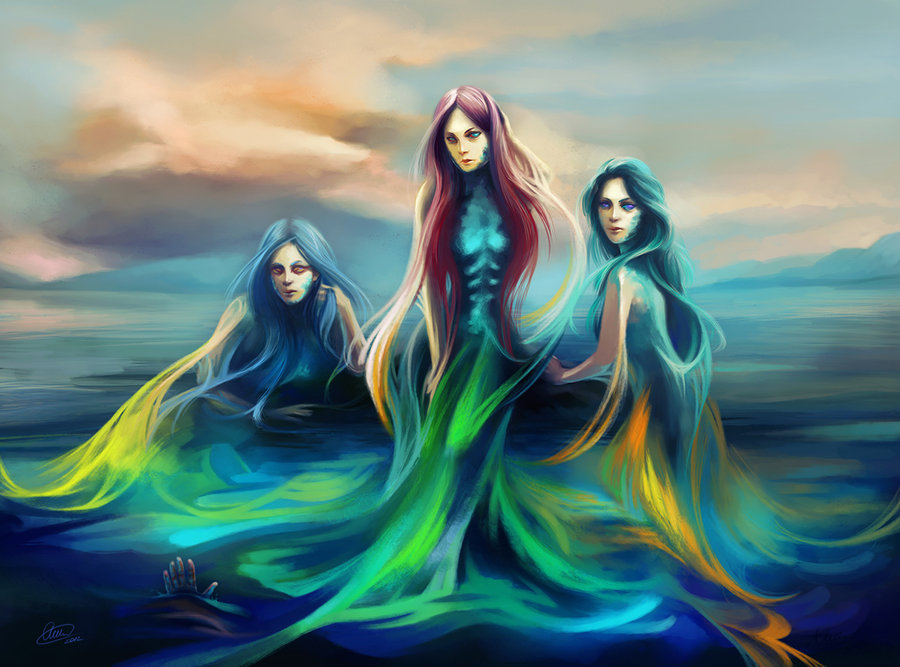
In Homer’s Odyssey, Odysseus wondered about the song of the Sirens and asked his men to plug their ears using beeswax and tie him tightly to the mast of the ship.
Hearing the beautiful song of the Sirens, Odysseus demanded his men to release him but they tied him even more strongly. They released Odysseus after they sailed away to a distance where Odysseus could not hear the song of the Sirens anymore.
According to some authors, the Sirens died if someone heard their songs but survived and the Sirens who called for Odysseus killed themselves by jumping into the water after Odysseus escaped.
Liked the content ? Then, share this mythical creatures list if you do not mind. Many thanks!



